Training Log Archive: BashIn the 7 days ending Feb 13, 2011:
| ||||||||||||||||||||||||||||||||||||||||||||||||||||||||||||||||||
| « | » |
| » now | ||||||||||
| Mo | Tu | We | Th | Fr | Sa | Su | |||||||
Sunday Feb 13, 2011 #
Note
To close off the story of Coast to Coast, here's what happened the day after the race. Between racers, staff and support crew, there were thousands of people involved in the event. We got together at the Christchurch Convention Centre and the place was super crowded. This was just one of the areas where people congregated.

There was a brunch going on upstairs and another large atrium where people were chatting and looking at results. Speaking of results, about 1 in 8 racers DNFed on the 1-day course. I noticed that the DNFs included Bib #s 91, 92, 93 and 94 (me). Curious about this trend, I looked closer and discovered something interesting. Although about 30% of the 1-day racers were from outside NZ (hard to determine since NZ locals like Elina Ussher and Emily Miazga represent Finland and Canada), about 50% of the DNFs were from outside NZ. Looking at it another way, about 1 in 11 New Zealanders in the 1-day race DNFed compared with 1 in 5 foreigners. So there is definitely an advantage to living close by, testing the course and learning as you try the race more than once. Oooh, I wish it were practical to try again next year! :)
The prize giving ceremony was held in the big convention hall.



With Speight's as the title sponsor, anyone called onto the stage got a case of 12 beer in addition to any other prizing.

Race Director Robin Judkins is quite a character and kept things as entertaining as possible for an awards ceremony that lasted well over 2 hours.
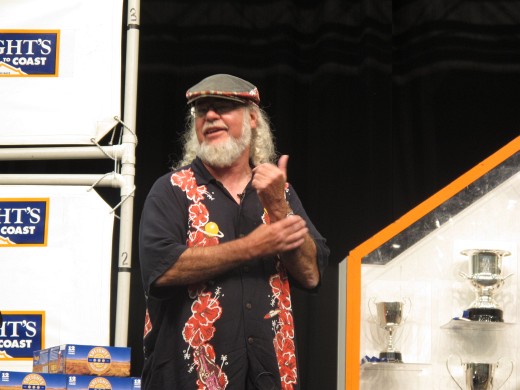
Along with the prizes for various categories, there were trophies for people who had done something extraordinary, e.g. helping a fellow competitor beyond the call of duty. There was even a prize for the person who placed 100th in the 1-day race. It had been donated in memory of a man who had been very proud of placing exactly 100th. There were all kinds of prizes for the 2-day race - individuals and teams in all different age/gender categories, school teams (who did not get beer) and so on. Not so many for the 1-day race, which was also the World Championship and was only open to individuals. There were terrific draw prizes although they tended to be large things like kayaks or car racks so we weren't too disappointed when we failed to win.
The IceBreaker mascot was easy on the eyes.

Top 10 women from left to right. 1st - Sophie Hart, 2nd - Elina Ussher, 3rd - Emily Miazga.

Jack gave a bottle of maple syrup to Robin Judkins before lining up with the top 10 men. There were only 3 non-New Zealanders in the top 30, and Jack did the best. We cheered wildly and hopefully didn't embarrass him too much.


The overall male and female winners gave a speech. Here's Richard Ussher.
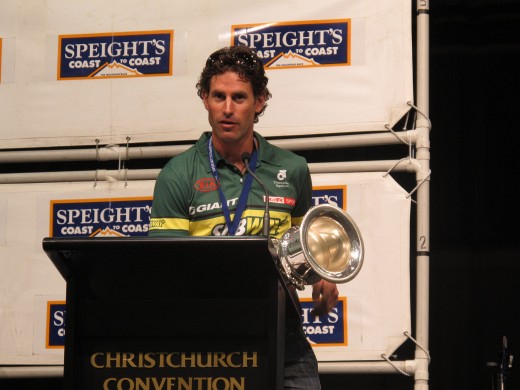
There's the top 10 men. From the left, 1st - Richard Ussher, 2nd - Dougal Allan, 3rd - Glen Currie.

As a race experience, Coast to Coast is definitely one to consider for your life list. It's not just the race itself, although the word "epic" likely applies to a race course that crosses an entire country from sea to sea including an Alpine pass and a 67 km whitewater river. What is most incredible for people in our obscure sport is the opportunity to participate in an event that everyone seems to know about and feel positive about. Whether we were in a grocery store, a hardware store or in a restaurant, if we got chatting to someone about it, they'd say, "Oh, are you doing the 1-day or the 2-day?" Or "I hear the Waimak water levels have been really high this week." Or "My wife and I live along the bike route in Christchurch. Every year we sit on the lawn for hours to cheer on the racers."
People bent over backwards to help us. New Zealanders are great people anyway, but as soon as we said the words "Coast to Coast" and indicated that we'd come to NZ specifically for the race, people from all walks of life went out of their way to make our experience as easy and positive as possible. Nobody said we were crazy fools. Most people had a story about a friend or relative doing the race. They respect this long-running event and they're proud of the way it shows off their beautiful country.
A small industry has sprung up around C2C. You can arrange guided runs over the Deception/Mingha route where different guides will compete to show you their faster shortcuts. Paddling outfitters run trips down the Waimakariri River. You can buy a detailed guidebook that covers the mountain run and paddling routes. Almost none of the course is marked so this is handy.
In outdoor stores, we could buy "multisport first aid kits" that just happened to have the exact items we needed for C2C. One store had a wall of C2C mandatory gear items on sale. Clerks could knowledgeably discuss whether a certain piece of gear would meet the criteria for the race. In some cases, the clerks were entered in the race themselves.
Jack and I were both mentioned in the Christchurch newspaper. The day after the event, the front page of the paper had a huge colour photo of Richard Ussher hugging Elina (the local equivalent of Brangelina) at the finish line, and all our race results - yes, even mine - sigh! - were listed along with a couple of news articles on the event.
There was even a radio station that broadcast C2C news all day.
This was all beyond anything I've experienced in adventure sports in North America, although the residents of Lower North Shore Quebec made us feel like rock stars at the Coast Raid, which was also amazing. If C2C sounds appealing to you at all, I'd say it is well worth doing at least once in your life.
There was a brunch going on upstairs and another large atrium where people were chatting and looking at results. Speaking of results, about 1 in 8 racers DNFed on the 1-day course. I noticed that the DNFs included Bib #s 91, 92, 93 and 94 (me). Curious about this trend, I looked closer and discovered something interesting. Although about 30% of the 1-day racers were from outside NZ (hard to determine since NZ locals like Elina Ussher and Emily Miazga represent Finland and Canada), about 50% of the DNFs were from outside NZ. Looking at it another way, about 1 in 11 New Zealanders in the 1-day race DNFed compared with 1 in 5 foreigners. So there is definitely an advantage to living close by, testing the course and learning as you try the race more than once. Oooh, I wish it were practical to try again next year! :)
The prize giving ceremony was held in the big convention hall.

With Speight's as the title sponsor, anyone called onto the stage got a case of 12 beer in addition to any other prizing.
Race Director Robin Judkins is quite a character and kept things as entertaining as possible for an awards ceremony that lasted well over 2 hours.
Along with the prizes for various categories, there were trophies for people who had done something extraordinary, e.g. helping a fellow competitor beyond the call of duty. There was even a prize for the person who placed 100th in the 1-day race. It had been donated in memory of a man who had been very proud of placing exactly 100th. There were all kinds of prizes for the 2-day race - individuals and teams in all different age/gender categories, school teams (who did not get beer) and so on. Not so many for the 1-day race, which was also the World Championship and was only open to individuals. There were terrific draw prizes although they tended to be large things like kayaks or car racks so we weren't too disappointed when we failed to win.
The IceBreaker mascot was easy on the eyes.

Top 10 women from left to right. 1st - Sophie Hart, 2nd - Elina Ussher, 3rd - Emily Miazga.

Jack gave a bottle of maple syrup to Robin Judkins before lining up with the top 10 men. There were only 3 non-New Zealanders in the top 30, and Jack did the best. We cheered wildly and hopefully didn't embarrass him too much.


The overall male and female winners gave a speech. Here's Richard Ussher.
There's the top 10 men. From the left, 1st - Richard Ussher, 2nd - Dougal Allan, 3rd - Glen Currie.

As a race experience, Coast to Coast is definitely one to consider for your life list. It's not just the race itself, although the word "epic" likely applies to a race course that crosses an entire country from sea to sea including an Alpine pass and a 67 km whitewater river. What is most incredible for people in our obscure sport is the opportunity to participate in an event that everyone seems to know about and feel positive about. Whether we were in a grocery store, a hardware store or in a restaurant, if we got chatting to someone about it, they'd say, "Oh, are you doing the 1-day or the 2-day?" Or "I hear the Waimak water levels have been really high this week." Or "My wife and I live along the bike route in Christchurch. Every year we sit on the lawn for hours to cheer on the racers."
People bent over backwards to help us. New Zealanders are great people anyway, but as soon as we said the words "Coast to Coast" and indicated that we'd come to NZ specifically for the race, people from all walks of life went out of their way to make our experience as easy and positive as possible. Nobody said we were crazy fools. Most people had a story about a friend or relative doing the race. They respect this long-running event and they're proud of the way it shows off their beautiful country.
A small industry has sprung up around C2C. You can arrange guided runs over the Deception/Mingha route where different guides will compete to show you their faster shortcuts. Paddling outfitters run trips down the Waimakariri River. You can buy a detailed guidebook that covers the mountain run and paddling routes. Almost none of the course is marked so this is handy.
In outdoor stores, we could buy "multisport first aid kits" that just happened to have the exact items we needed for C2C. One store had a wall of C2C mandatory gear items on sale. Clerks could knowledgeably discuss whether a certain piece of gear would meet the criteria for the race. In some cases, the clerks were entered in the race themselves.
Jack and I were both mentioned in the Christchurch newspaper. The day after the event, the front page of the paper had a huge colour photo of Richard Ussher hugging Elina (the local equivalent of Brangelina) at the finish line, and all our race results - yes, even mine - sigh! - were listed along with a couple of news articles on the event.
There was even a radio station that broadcast C2C news all day.
This was all beyond anything I've experienced in adventure sports in North America, although the residents of Lower North Shore Quebec made us feel like rock stars at the Coast Raid, which was also amazing. If C2C sounds appealing to you at all, I'd say it is well worth doing at least once in your life.
Saturday Feb 12, 2011 #
6 AM
Adventure Racing race (Multisport) 9:07:00 105.43 km (5:11 / km) +1886m 4:46 / km
shoes: Salomon XA Pro Tomato 3
Five months after the start of my Coast to Coast adventure, race day was finally here! Our alarm went off at 4 a.m. (yawn) after a short night. We were lucky though; the alarm in the Van Dorp family cabin went off at 3 a.m. after a finger slipped while setting the clock.
I got dressed and had a small breakfast with strong coffee. There wasn't much room in my stomach with all the butterflies in there.

It was about 20 minutes from our motel to the bike stands where we left our bikes and shoes lined up in order of our race numbers. I had a small coloured glow stick on my bike so it would be recognizable from a distance.
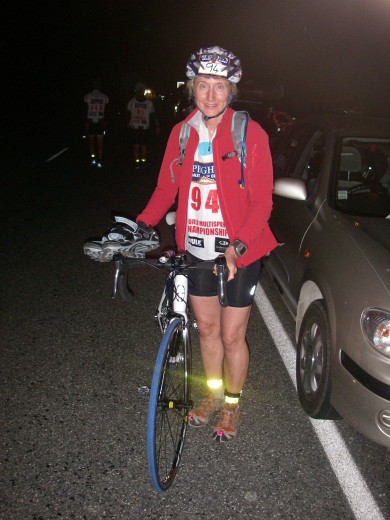
We could wear extra clothing to the start and they would take it to the end of the mountain run. Same with any running shoes we left at the bike racks after changing into bike shoes. As an aside, Speight's Coast to Coast is an absolute masterpiece of organization. There are 450 people working on the race ranging from paid safety specialists to a huge number of volunteers. The event is in its 29th year and has had the same title sponsor for 22 years so it has been able to grow and mature in a way that few other adventure events in the world have done. The entry fee for the 1-day race is about $800 Canadian so you pay for what you get but it is definitely a class act.
Anyway, back to the bike racks... Jack had race number 4 so he would be one of the first runners to reach his bike after the run.
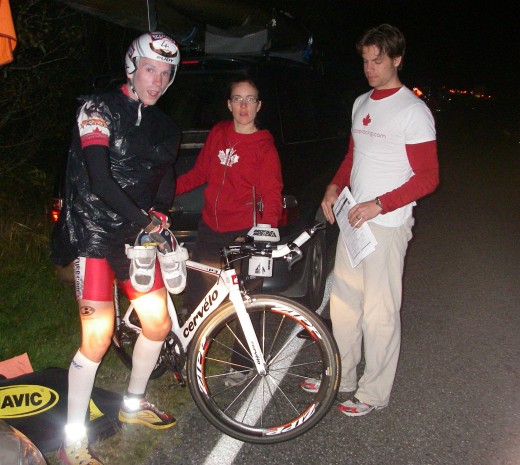
Pieces of gooey energy bar were stuck to his top tube. Yum, so appetizing!
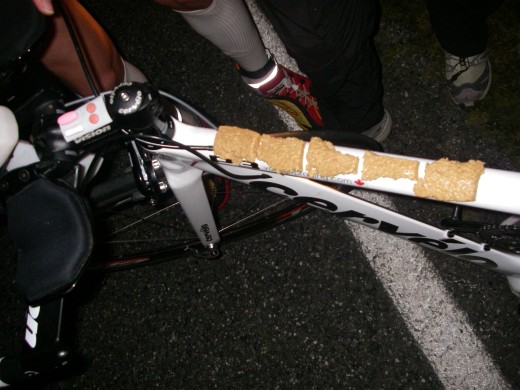
From here, it was close to 3 km to the starting line at Kumara Beach and we had to get there on foot without lights. I crossed my fingers that I wouldn't turn my ankle in a pothole. Along the way, I got chatting to a couple of New Zealanders. Upon learning I was from Canada, one of them asked me, "Are you the one writing posts on Attackpoint about this?" Small world! "Rabbit" said he was really enjoying the photos. I never know who reads my blog but it is always a nice surprise to learn about people I haven't met.
We headed down to the beach (see Wed. Feb. 9 log entry for beach pics). Most of us walked over to the water's edge in the moonlight and waited for a tame wave so we could stick our toe in the Tasman Sea. We were supposed to line up according to race number but it seemed to be just a big pack of people on the beach. I found some numbers in the same ballpark as mine and we wished one other good luck. It was still dark so we could barely see race director Robin Judkins as he counted down the last couple of minutes.
GO!! I ran three steps before bumping into some unseen-in-the-dark obstacle at shin height (hummock? piece of driftwood?) that knocked me onto my face. The fall was nothing serious but I'd already taken a starting position near the back of the pack and now I had lost another 3-4 precious seconds. By the time I scrambled up the big boulders onto the road, I was at the back of the line of runners. At the best of times, I'm not a sprinter, especially at the start of a 243-km race.
As it turns out, this short road run was the crux of my race even though it never seemed like I was that far behind the main pack. Looking at the Garmin data, the pace of my 2nd kilometer (the only "pure" road running km) was about 10 seconds/km slower than my 10K race pace so maybe a longer warm-up would have helped. Or maybe I should have focused on treadmill speed intervals this winter instead of all the trail running and paddling that I thought would be so important for C2C. ;) Forget that - this stuff is supposed to be fun!
Compared to yesterday's 2-day racers, these people were flying. In fact, a new course record was set today for the combined 3 km run / 55 km bike section. Apparently, some years the race starts more slowly than others. Just my luck to hit the fastest year ever! By the time I hopped on my bike (#94 - a long run along the racks in numerical order), I was in last place. Ugh.
In most long events, this would be no big deal. I often start out near the back then work my way up the ranks because I feel better as a long race progresses. However, in C2C, it is a *huge* deal to be at the back at the start because the next 55 km bike ride is the only draft-legal section of the race. Riders set out in various groups working together at different paces. I wasn't far behind the last group when I started riding, and I pedalled after their tail lights like a madwoman. But a group of riders working together can go much faster than any single rider so I never really had a chance. It took me a number of kilometers of hammering to reach that sad conclusion. Even if I'd had one other rider to share the work with, I could have avoided the full brunt of the wind half the time. I did catch one guy but he wasn't doing well so he asked me to keep going. Looking at the results later, it appears that maybe 3-4 riders out of 159 rode the full distance by themselves. Even the last pair of riders who were together finished the run/bike leg about 20 minutes faster than I did. Jack and the lead pack were 56 minutes ahead of me in their record time.
The horrible thought - "my race is over" - flashed through my mind briefly then I banished it for good. I'd never cared about beating any other competitor. I only wanted to beat the time cut-offs and now I was going to have to work my butt off to make that happen. There were ups and downs on this 55 km bike ride with a net climb of about 350 meters as we headed into the Alps. In some stretches, I was fighting a headwind - argghh. The highway was closed so I only saw occasional race vehicles and volunteers for over two hours. It was dark and I was feeling a bit lonely when I remembered to listen very carefully... and then I could "hear" friends back in Canada saying, "Go Barb go"! :) Thanks to those of you who followed the race real time and also to the people who followed my log and gave support leading up to the race. You have no idea how much strength I drew from you all that morning.
Physically, I was working much harder than I wanted to that early in the race but I felt good otherwise. The one bad thing was that my knees got a little sore from pushing hard on the uphills. I tried to keep a high cadence but I know I cheated at times because I felt such a sense of urgency. I stood up on my pedals more than I ever have!
While I was on the road, Richard and Andrew were waiting in the bike/run TA at Aicken's Corner with the other support crews.


At 2 hrs 34 min, shortly after they'd given me up for dead, I finally rolled into the TA.

We had a super quick transition then I was off on the run having moved up to (woo hoo!) 3rd last place. (The rider behind me dropped out injured and I passed a guy in the TA.) We started by running 3 km on private farmland that we hadn't been able to access on our training runs.
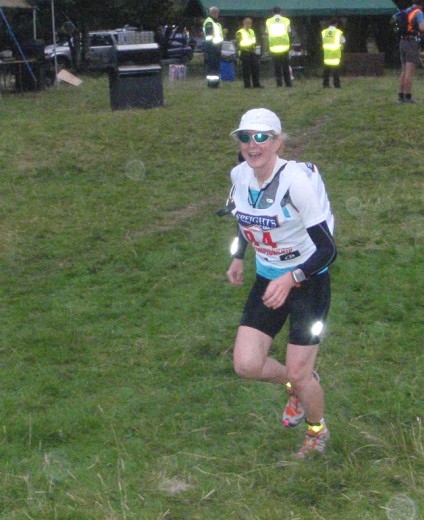
They sent us a fair distance upstream to cross the Otira River after some racers went swimming on purpose yesterday. Then I headed up the now-familiar Deception Valley. The river was fairly high and I got swept away for a swim on my second crossing of the Deception. I was so happy to be off my bike that I was running at a good pace whenever the terrain allowed it. For the most part, I remembered where the crossings and hidden trail fragments were. When I couldn't, I played it by ear and things went well. In the upper reaches of the Deception, I caught up with several other runners and we stayed together for the final section, much of which is power walking on steep, slippery, rooty trails and climbing over big boulders.
Somewhere in here, I stepped off a big boulder onto some rocks and hyper-extended my right knee, which was hurting from the long solo bike ride. It had already been bruised and swollen all week after I'd banged into a boulder during one of my river crossing swims when we test ran the course. By this point, my knee was getting seriously peeved at me for being so careless. As we approached Goat Pass, it was inflamed enough that I started to wonder whether I could be causing permanent damage. If Goat Pass had been at a road, I would have had to seriously consider the wisdom of dropping out.
But since I was on top of a wilderness mountain pass, I figured I might as well keep going down the other side. While my run up Goat Pass was faster than our training run, my time going down to the TA was about the same. I was tentative about landing too hard on that knee when there were big drops. I'd expected to go harder on race day but after watching Richard with his knee problems for the past 18 months, I didn't want to end up in the same boat. Even so, my overall mountain run time (5 hrs 51 min) was faster than our estimate. Combined with a proper group bike ride, I would have been in good shape at this point.
Photo credit to Paul's Camera Shop for several pics of me on the mountain run.



Richard and Andrew were waiting and watching at the run/bike TA at Klondyke Corner.



Richard Ussher's support crew member carried his racer's gear on a belt.

Ussher's transitions are smooooooth.

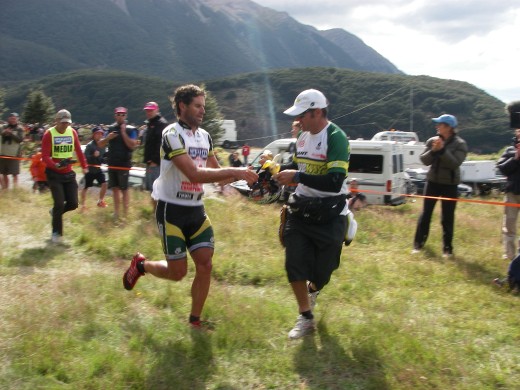
Our friend Sam Clark came in looking strong just a few minutes after Richard. More on him later.

Waiting for Jack, the boys wore some of his gear so it would be ready to transfer quickly.

No photos of Jack since all hands were on deck when he was in the TA. So here's a photo of someone else with his crew and you'll just have to pretend it is Jack.

One thing that went right today was the TAs. We were so efficient that I don't think I could have gained any time there. Richard and Andrew were awesome. We'd planned and discussed everything in detail and they made smart decisions on the fly. My crew didn't let me stand still for any longer than it took to change shoes - and after my transition practice with Jack, that went quickly! The boys said that our TAs were faster than many of the racers in our part of the pack. Of course, when you're fast enough on the race course, you can afford an extra minute or two in the TA.

Late in the run, I looked at my watch frequently, as if it would suddenly change its mind and tell me better news. The problem was this: I had to arrive on the north side of Mt. Whyte bridge by 3 p.m. That was the TA for the start of the kayak section. If I got there by 3 p.m., I had till 3:15 p.m. to get my boat in the water, which would be simple. To get there from the end of the mountain run, I had to do a hilly 15 km bike ride followed by an 800 meter run down a gravel road in bike shoes to get across the bridge. As I ran down the Mingha Valley, I kept doing the math and trying to be optimistic. A few kilometers from the end, I realized I was too late but I still wanted to push hard to miss the cut-off by as little as possible. A brief wave of emotion washed over me but after exactly one dry-eyed, gut wrenching sob, I was fine - and I've been fine about it ever since. When I scrambled up the bank into the Klondyke Corner TA, I expected my crew to tell me we had to pull the plug.


But no! An official had told Richard that the 3 p.m. arrival cut-off at Mt. Whyte was soft - that I should be fine as long as I could start paddling by 3:15 p.m. Sure, I could do that. No problem. So Richard ran with me along the chute and we planned what we would do after I'd crossed the timing mat when he would be allowed to start helping me.

I didn't take off my run pack - just asked Richard to pull all the mandatory mountain gear out of it, then I grabbed my bike shoes and helmet from Andrew and took off super quickly at 2:29 p.m.. So quickly that I had a big hunk of hair sticking out the front of my helmet over my face so I couldn't see very well! The next 15 km of biking was twisty and hilly, and the highway was open to traffic, so it would have been nice to be able to see. I pushed hard and it went well. I got over 50 kph on two curving descents with guard rails and steep drop-offs. Maybe it was best that I couldn't see! On one of the climbs I could feel a tailwind pushing me up. The road twisted enough that the wind wasn't always going in a helpful direction though.
Richard and Andrew packed up at the run/bike TA and sped past me to get to the bike/kayak TA before I did.


I got to the bike drop, then Richard and I ran together down the gravel road to Mt. Whyte bridge. I had 800 meters to run in bike shoes. Andrew was waiting on the far side of the bridge with my kayak. Chris and Nelvia had taken both kayaks there in the morning for "scrutineering", a formal check of the kayak and all mandatory gear. Andrew waited with my kayak until the official counted down and said, "OK, this TA is closed". Andrew picked up my boat immediately and walked along the riverbank to the bridge. Richard and I met him on the bridge so it's possible that the cut-off was extended a little after 3 p.m. on my watch. However, when I got across the bridge, it was 3:07 and I'd missed it for sure. The cut-off time to launch my kayak would have been 3:15 p.m. and it would have been easy to do that - but the rules don't work that way.
As it turns out, I was lucky. They cut off one of the women I'd met on the run even though she arrived *before* 3 p.m. They wouldn't let her go because she had a plastic kayak; they said she would hold up the sweep kayakers. I met another fellow who was told at 2:15 p.m. that they recommended against him going unless he was an experienced paddler because the wind was strong in the Gorge. He'd had a couple of swims on his training run so decided to call it a day. If I'd been there by 3 p.m. it would have taken a team of wild horses to prevent me from getting into my kayak! :)
It would have been a challenging day on the river. A number of kayakers, including Jack, were blown over by the wind. (Jack rolled up.) The day after the race, they had to extract 30 boats that were left behind, mostly by 2-day racers. Reviewing the times for the leg, it looks like a 3 p.m. arrival would have given me a shot at making it down the river before the cut-off in a moderately fast boat with reasonable paddling skills. I would have had to work hard to keep the pace up and do my best to avoid swimming. It wouldn't have been easy but I would like to have tried.
After sticking my toe in the Tasman Sea at the start, I decided it would be appropriate to stick my toe into the Waimakariri River where I finished. I didn't do Coast to Coast - just Coast Over The Alps to the Upper River. But at least I wanted to do it properly!

Such a beautiful place! It's a sign of progress that I was genuinely disappointed when I was denied the chance to paddle 67 km of whitewater at a relatively high water level. A few months ago, I might have been secretly relieved.
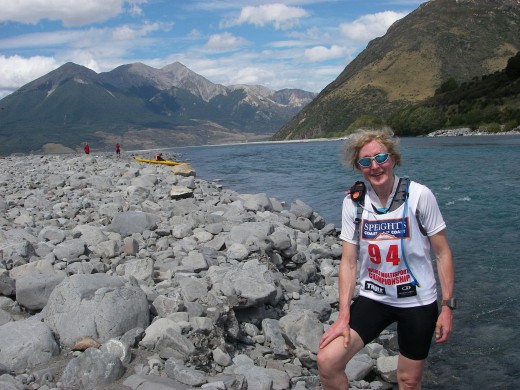
It's a bit of a production to get DNF'ed in a big event like this. I had to fill out and sign a form stating the reason for my DNF. The other woman in the photo is Shelley, the Australian woman with whom I ran the upper part of Goat Pass. She was the one turned back for having a plastic kayak.
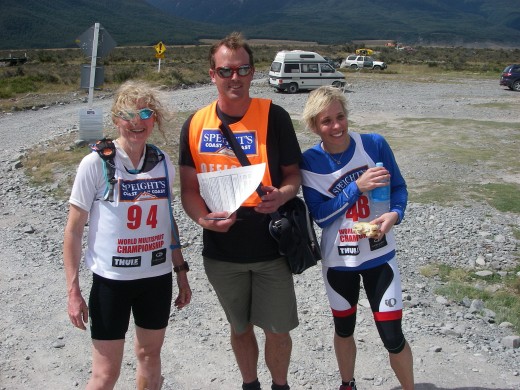
Even worse, after doing the paperwork, the official had to strip us of our bibs! Some competitors find it tempting to continue from Coast to Coast using some other mode of transportation, e.g. biking to the finish. So they don't want you to look like you're in the race anymore. I'm hoping I will get my bib back some day; the official said that I would. Sniff sniff!
We packed up the car, looked at our watches and decided that Jack was already biking to the finish in Sumner Beach so we had better head straight there.

As soon as we got back into cell phone range, I checked Attackpoint and was stunned to see the "RACE DAY" thread on my log with 80 comments. I read them out loud to Richard and Andrew as we sped toward Christchurch. Chris, it is so cool that you prepared the map with TA locations and cut-off times. You made the race much more understandable for online spectators. Valerie, we were laughing so hard at your version of my race report that we nearly went off the road. We were blown away by how accurately you guys collectively guessed what was going on. Thanks so much to all of you who made me smile at a time when I might have started to feel down.
We parked by the finish line in Sumner Beach and dashed over to see who had come in. Only Richard Ussher (10 hrs 41 min) and a few other racers were done. We positioned ourselves to get good photos of Jack.



He finished looking strong and happy, placing 9th in a time of 11 hrs 58 min.

When you cross the finish line, they hand you a Speight's Ale.

When you DNF, they hand you nothing but a form to sign before stripping you of your bib. Honestly, I think the DNFers need the alcohol more than the finishers. But I digress...
As the only non-New Zealander in the top 10, Jack was a big enough deal that he had to be interviewed by the media before we could get to him.

A very proud group of Canadians!
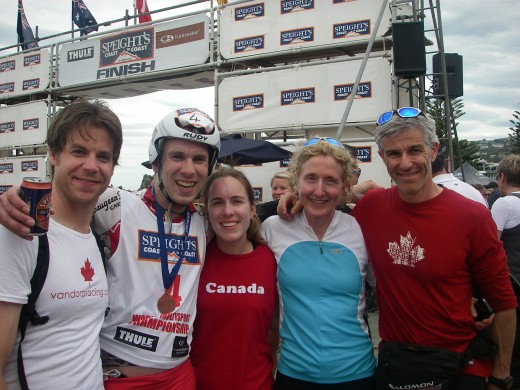
Race Director Robin Judkins congratulated Jack too.
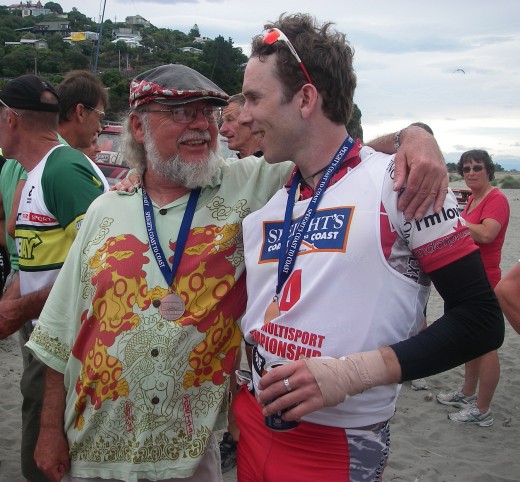
Richard Ussher was waiting for his wife Elina to cross the line.
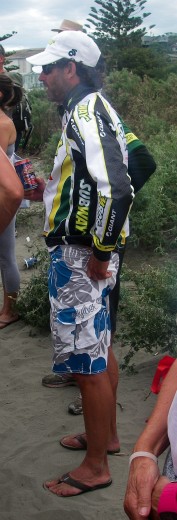
Jack went over to congratulate Richard - and possibly to do some trash talking before their next race. Not sure. ;)

Dr. Sophie Hart, a multi-sport athlete from Nelson, took the win for the first time. She was so filled with joy, it was contagious.

Elina placed second and looked tired after a big effort. She had the fastest mountain run but got passed on the kayak.


Remember I was saying that her kayak looked wider than I'd expected for a top athlete? It turns out she has two kayaks that she uses on the Waimakariri River depending on the conditions. The wider kayak is for higher river levels.
Nathan Fa'avae was with the Media crew.

Jack is with Bill (left) and Sam Clark, a super friendly father and son we met half a dozen times during our trip to New Zealand. They were doing the same thing we were - testing different pieces of the course leading up to the race. When we did our training run up the Deception/Mingha, Sam was just starting as we arrived so Jack had a running buddy to push the pace. Sam won the 2-day race in 2008. This year he tried the 1-day race and placed 5th. He was just 5 minutes behind Richard Ussher after the mountain run. By the way, did I mention that Sam is 20 years old?!? Talk about an amazingly bright future in endurance sports!

After watching the top finishers come in, we all relaxed, asked each other about our respective days, and enjoyed the beach. No, just kidding. We all started tapping madly on our phones, ignoring each other completely as we sent out news flashes. ;)

We'd managed to score an amazing apartment overlooking the finish line so we sat out on the porch in the evening and watched until the last finisher came in around 10:40 p.m.

Huge congratulations to Jack on an awesome performance! And a big thank you to our amazing support crew - Richard, Andrew, Chris and Nelvia. It was fun travelling with the gang around New Zealand and it was a great experience to see how a top racer like Jack approaches an event like this.
As for me, of course I would have loved to finish C2C. I always knew that the cut-offs were going to be tight if not impossible - although I wasn't expecting it to happen quite the way it did. As it turns out, my mountain running and kayaking skills/speed were sufficient to finish the race on time. My road running sprints, however, need work.
Some time ago, organizers had advised us to switch to the 2-day race if we had any concerns about meeting cut-offs. If it was only about finishing ranked, that's what I would have done but I really wanted to take a shot at being the age group World Multisport Champion even if it meant going down in flames.
The 1-day event isn't really aimed at people like me. Only 24 of the 159 competitors in the 1-day race were women and only a handful of them were over 40. Almost all of them live in NZ and can train on the race course more often than I did. Comparing the Day 1 part of my course with the 2-day race results, I would have been leading my category by over an hour after the first day. So I think I made the right choice. I can come back to do the 2-day event another time, and I hope I do. But I'm glad I tried to "go big" this year, even though I ended up "going home".
No regrets whatsoever about the amazing 5-month adventure of preparing for and racing in C2C. It's been terrific training for anything I might do. I've become a stronger racer, improved my skills, deepened friendships and had a load of fun. I guess there is one regret... the fact that it's over now! I'll need to find a new adventure soon to keep things fun and motivating. Some ideas are brewing. Stay tuned to this space. :)
I got dressed and had a small breakfast with strong coffee. There wasn't much room in my stomach with all the butterflies in there.

It was about 20 minutes from our motel to the bike stands where we left our bikes and shoes lined up in order of our race numbers. I had a small coloured glow stick on my bike so it would be recognizable from a distance.

We could wear extra clothing to the start and they would take it to the end of the mountain run. Same with any running shoes we left at the bike racks after changing into bike shoes. As an aside, Speight's Coast to Coast is an absolute masterpiece of organization. There are 450 people working on the race ranging from paid safety specialists to a huge number of volunteers. The event is in its 29th year and has had the same title sponsor for 22 years so it has been able to grow and mature in a way that few other adventure events in the world have done. The entry fee for the 1-day race is about $800 Canadian so you pay for what you get but it is definitely a class act.
Anyway, back to the bike racks... Jack had race number 4 so he would be one of the first runners to reach his bike after the run.

Pieces of gooey energy bar were stuck to his top tube. Yum, so appetizing!
From here, it was close to 3 km to the starting line at Kumara Beach and we had to get there on foot without lights. I crossed my fingers that I wouldn't turn my ankle in a pothole. Along the way, I got chatting to a couple of New Zealanders. Upon learning I was from Canada, one of them asked me, "Are you the one writing posts on Attackpoint about this?" Small world! "Rabbit" said he was really enjoying the photos. I never know who reads my blog but it is always a nice surprise to learn about people I haven't met.
We headed down to the beach (see Wed. Feb. 9 log entry for beach pics). Most of us walked over to the water's edge in the moonlight and waited for a tame wave so we could stick our toe in the Tasman Sea. We were supposed to line up according to race number but it seemed to be just a big pack of people on the beach. I found some numbers in the same ballpark as mine and we wished one other good luck. It was still dark so we could barely see race director Robin Judkins as he counted down the last couple of minutes.
GO!! I ran three steps before bumping into some unseen-in-the-dark obstacle at shin height (hummock? piece of driftwood?) that knocked me onto my face. The fall was nothing serious but I'd already taken a starting position near the back of the pack and now I had lost another 3-4 precious seconds. By the time I scrambled up the big boulders onto the road, I was at the back of the line of runners. At the best of times, I'm not a sprinter, especially at the start of a 243-km race.
As it turns out, this short road run was the crux of my race even though it never seemed like I was that far behind the main pack. Looking at the Garmin data, the pace of my 2nd kilometer (the only "pure" road running km) was about 10 seconds/km slower than my 10K race pace so maybe a longer warm-up would have helped. Or maybe I should have focused on treadmill speed intervals this winter instead of all the trail running and paddling that I thought would be so important for C2C. ;) Forget that - this stuff is supposed to be fun!
Compared to yesterday's 2-day racers, these people were flying. In fact, a new course record was set today for the combined 3 km run / 55 km bike section. Apparently, some years the race starts more slowly than others. Just my luck to hit the fastest year ever! By the time I hopped on my bike (#94 - a long run along the racks in numerical order), I was in last place. Ugh.
In most long events, this would be no big deal. I often start out near the back then work my way up the ranks because I feel better as a long race progresses. However, in C2C, it is a *huge* deal to be at the back at the start because the next 55 km bike ride is the only draft-legal section of the race. Riders set out in various groups working together at different paces. I wasn't far behind the last group when I started riding, and I pedalled after their tail lights like a madwoman. But a group of riders working together can go much faster than any single rider so I never really had a chance. It took me a number of kilometers of hammering to reach that sad conclusion. Even if I'd had one other rider to share the work with, I could have avoided the full brunt of the wind half the time. I did catch one guy but he wasn't doing well so he asked me to keep going. Looking at the results later, it appears that maybe 3-4 riders out of 159 rode the full distance by themselves. Even the last pair of riders who were together finished the run/bike leg about 20 minutes faster than I did. Jack and the lead pack were 56 minutes ahead of me in their record time.
The horrible thought - "my race is over" - flashed through my mind briefly then I banished it for good. I'd never cared about beating any other competitor. I only wanted to beat the time cut-offs and now I was going to have to work my butt off to make that happen. There were ups and downs on this 55 km bike ride with a net climb of about 350 meters as we headed into the Alps. In some stretches, I was fighting a headwind - argghh. The highway was closed so I only saw occasional race vehicles and volunteers for over two hours. It was dark and I was feeling a bit lonely when I remembered to listen very carefully... and then I could "hear" friends back in Canada saying, "Go Barb go"! :) Thanks to those of you who followed the race real time and also to the people who followed my log and gave support leading up to the race. You have no idea how much strength I drew from you all that morning.
Physically, I was working much harder than I wanted to that early in the race but I felt good otherwise. The one bad thing was that my knees got a little sore from pushing hard on the uphills. I tried to keep a high cadence but I know I cheated at times because I felt such a sense of urgency. I stood up on my pedals more than I ever have!
While I was on the road, Richard and Andrew were waiting in the bike/run TA at Aicken's Corner with the other support crews.

At 2 hrs 34 min, shortly after they'd given me up for dead, I finally rolled into the TA.

We had a super quick transition then I was off on the run having moved up to (woo hoo!) 3rd last place. (The rider behind me dropped out injured and I passed a guy in the TA.) We started by running 3 km on private farmland that we hadn't been able to access on our training runs.

They sent us a fair distance upstream to cross the Otira River after some racers went swimming on purpose yesterday. Then I headed up the now-familiar Deception Valley. The river was fairly high and I got swept away for a swim on my second crossing of the Deception. I was so happy to be off my bike that I was running at a good pace whenever the terrain allowed it. For the most part, I remembered where the crossings and hidden trail fragments were. When I couldn't, I played it by ear and things went well. In the upper reaches of the Deception, I caught up with several other runners and we stayed together for the final section, much of which is power walking on steep, slippery, rooty trails and climbing over big boulders.
Somewhere in here, I stepped off a big boulder onto some rocks and hyper-extended my right knee, which was hurting from the long solo bike ride. It had already been bruised and swollen all week after I'd banged into a boulder during one of my river crossing swims when we test ran the course. By this point, my knee was getting seriously peeved at me for being so careless. As we approached Goat Pass, it was inflamed enough that I started to wonder whether I could be causing permanent damage. If Goat Pass had been at a road, I would have had to seriously consider the wisdom of dropping out.
But since I was on top of a wilderness mountain pass, I figured I might as well keep going down the other side. While my run up Goat Pass was faster than our training run, my time going down to the TA was about the same. I was tentative about landing too hard on that knee when there were big drops. I'd expected to go harder on race day but after watching Richard with his knee problems for the past 18 months, I didn't want to end up in the same boat. Even so, my overall mountain run time (5 hrs 51 min) was faster than our estimate. Combined with a proper group bike ride, I would have been in good shape at this point.
Photo credit to Paul's Camera Shop for several pics of me on the mountain run.



Richard and Andrew were waiting and watching at the run/bike TA at Klondyke Corner.
Richard Ussher's support crew member carried his racer's gear on a belt.
Ussher's transitions are smooooooth.

Our friend Sam Clark came in looking strong just a few minutes after Richard. More on him later.

Waiting for Jack, the boys wore some of his gear so it would be ready to transfer quickly.

No photos of Jack since all hands were on deck when he was in the TA. So here's a photo of someone else with his crew and you'll just have to pretend it is Jack.

One thing that went right today was the TAs. We were so efficient that I don't think I could have gained any time there. Richard and Andrew were awesome. We'd planned and discussed everything in detail and they made smart decisions on the fly. My crew didn't let me stand still for any longer than it took to change shoes - and after my transition practice with Jack, that went quickly! The boys said that our TAs were faster than many of the racers in our part of the pack. Of course, when you're fast enough on the race course, you can afford an extra minute or two in the TA.
Late in the run, I looked at my watch frequently, as if it would suddenly change its mind and tell me better news. The problem was this: I had to arrive on the north side of Mt. Whyte bridge by 3 p.m. That was the TA for the start of the kayak section. If I got there by 3 p.m., I had till 3:15 p.m. to get my boat in the water, which would be simple. To get there from the end of the mountain run, I had to do a hilly 15 km bike ride followed by an 800 meter run down a gravel road in bike shoes to get across the bridge. As I ran down the Mingha Valley, I kept doing the math and trying to be optimistic. A few kilometers from the end, I realized I was too late but I still wanted to push hard to miss the cut-off by as little as possible. A brief wave of emotion washed over me but after exactly one dry-eyed, gut wrenching sob, I was fine - and I've been fine about it ever since. When I scrambled up the bank into the Klondyke Corner TA, I expected my crew to tell me we had to pull the plug.


But no! An official had told Richard that the 3 p.m. arrival cut-off at Mt. Whyte was soft - that I should be fine as long as I could start paddling by 3:15 p.m. Sure, I could do that. No problem. So Richard ran with me along the chute and we planned what we would do after I'd crossed the timing mat when he would be allowed to start helping me.

I didn't take off my run pack - just asked Richard to pull all the mandatory mountain gear out of it, then I grabbed my bike shoes and helmet from Andrew and took off super quickly at 2:29 p.m.. So quickly that I had a big hunk of hair sticking out the front of my helmet over my face so I couldn't see very well! The next 15 km of biking was twisty and hilly, and the highway was open to traffic, so it would have been nice to be able to see. I pushed hard and it went well. I got over 50 kph on two curving descents with guard rails and steep drop-offs. Maybe it was best that I couldn't see! On one of the climbs I could feel a tailwind pushing me up. The road twisted enough that the wind wasn't always going in a helpful direction though.
Richard and Andrew packed up at the run/bike TA and sped past me to get to the bike/kayak TA before I did.

I got to the bike drop, then Richard and I ran together down the gravel road to Mt. Whyte bridge. I had 800 meters to run in bike shoes. Andrew was waiting on the far side of the bridge with my kayak. Chris and Nelvia had taken both kayaks there in the morning for "scrutineering", a formal check of the kayak and all mandatory gear. Andrew waited with my kayak until the official counted down and said, "OK, this TA is closed". Andrew picked up my boat immediately and walked along the riverbank to the bridge. Richard and I met him on the bridge so it's possible that the cut-off was extended a little after 3 p.m. on my watch. However, when I got across the bridge, it was 3:07 and I'd missed it for sure. The cut-off time to launch my kayak would have been 3:15 p.m. and it would have been easy to do that - but the rules don't work that way.
As it turns out, I was lucky. They cut off one of the women I'd met on the run even though she arrived *before* 3 p.m. They wouldn't let her go because she had a plastic kayak; they said she would hold up the sweep kayakers. I met another fellow who was told at 2:15 p.m. that they recommended against him going unless he was an experienced paddler because the wind was strong in the Gorge. He'd had a couple of swims on his training run so decided to call it a day. If I'd been there by 3 p.m. it would have taken a team of wild horses to prevent me from getting into my kayak! :)
It would have been a challenging day on the river. A number of kayakers, including Jack, were blown over by the wind. (Jack rolled up.) The day after the race, they had to extract 30 boats that were left behind, mostly by 2-day racers. Reviewing the times for the leg, it looks like a 3 p.m. arrival would have given me a shot at making it down the river before the cut-off in a moderately fast boat with reasonable paddling skills. I would have had to work hard to keep the pace up and do my best to avoid swimming. It wouldn't have been easy but I would like to have tried.
After sticking my toe in the Tasman Sea at the start, I decided it would be appropriate to stick my toe into the Waimakariri River where I finished. I didn't do Coast to Coast - just Coast Over The Alps to the Upper River. But at least I wanted to do it properly!
Such a beautiful place! It's a sign of progress that I was genuinely disappointed when I was denied the chance to paddle 67 km of whitewater at a relatively high water level. A few months ago, I might have been secretly relieved.
It's a bit of a production to get DNF'ed in a big event like this. I had to fill out and sign a form stating the reason for my DNF. The other woman in the photo is Shelley, the Australian woman with whom I ran the upper part of Goat Pass. She was the one turned back for having a plastic kayak.
Even worse, after doing the paperwork, the official had to strip us of our bibs! Some competitors find it tempting to continue from Coast to Coast using some other mode of transportation, e.g. biking to the finish. So they don't want you to look like you're in the race anymore. I'm hoping I will get my bib back some day; the official said that I would. Sniff sniff!
We packed up the car, looked at our watches and decided that Jack was already biking to the finish in Sumner Beach so we had better head straight there.
As soon as we got back into cell phone range, I checked Attackpoint and was stunned to see the "RACE DAY" thread on my log with 80 comments. I read them out loud to Richard and Andrew as we sped toward Christchurch. Chris, it is so cool that you prepared the map with TA locations and cut-off times. You made the race much more understandable for online spectators. Valerie, we were laughing so hard at your version of my race report that we nearly went off the road. We were blown away by how accurately you guys collectively guessed what was going on. Thanks so much to all of you who made me smile at a time when I might have started to feel down.
We parked by the finish line in Sumner Beach and dashed over to see who had come in. Only Richard Ussher (10 hrs 41 min) and a few other racers were done. We positioned ourselves to get good photos of Jack.

He finished looking strong and happy, placing 9th in a time of 11 hrs 58 min.

When you cross the finish line, they hand you a Speight's Ale.

When you DNF, they hand you nothing but a form to sign before stripping you of your bib. Honestly, I think the DNFers need the alcohol more than the finishers. But I digress...
As the only non-New Zealander in the top 10, Jack was a big enough deal that he had to be interviewed by the media before we could get to him.
A very proud group of Canadians!
Race Director Robin Judkins congratulated Jack too.

Richard Ussher was waiting for his wife Elina to cross the line.

Jack went over to congratulate Richard - and possibly to do some trash talking before their next race. Not sure. ;)

Dr. Sophie Hart, a multi-sport athlete from Nelson, took the win for the first time. She was so filled with joy, it was contagious.

Elina placed second and looked tired after a big effort. She had the fastest mountain run but got passed on the kayak.

Remember I was saying that her kayak looked wider than I'd expected for a top athlete? It turns out she has two kayaks that she uses on the Waimakariri River depending on the conditions. The wider kayak is for higher river levels.
Nathan Fa'avae was with the Media crew.

Jack is with Bill (left) and Sam Clark, a super friendly father and son we met half a dozen times during our trip to New Zealand. They were doing the same thing we were - testing different pieces of the course leading up to the race. When we did our training run up the Deception/Mingha, Sam was just starting as we arrived so Jack had a running buddy to push the pace. Sam won the 2-day race in 2008. This year he tried the 1-day race and placed 5th. He was just 5 minutes behind Richard Ussher after the mountain run. By the way, did I mention that Sam is 20 years old?!? Talk about an amazingly bright future in endurance sports!

After watching the top finishers come in, we all relaxed, asked each other about our respective days, and enjoyed the beach. No, just kidding. We all started tapping madly on our phones, ignoring each other completely as we sent out news flashes. ;)
We'd managed to score an amazing apartment overlooking the finish line so we sat out on the porch in the evening and watched until the last finisher came in around 10:40 p.m.
Huge congratulations to Jack on an awesome performance! And a big thank you to our amazing support crew - Richard, Andrew, Chris and Nelvia. It was fun travelling with the gang around New Zealand and it was a great experience to see how a top racer like Jack approaches an event like this.
As for me, of course I would have loved to finish C2C. I always knew that the cut-offs were going to be tight if not impossible - although I wasn't expecting it to happen quite the way it did. As it turns out, my mountain running and kayaking skills/speed were sufficient to finish the race on time. My road running sprints, however, need work.
Some time ago, organizers had advised us to switch to the 2-day race if we had any concerns about meeting cut-offs. If it was only about finishing ranked, that's what I would have done but I really wanted to take a shot at being the age group World Multisport Champion even if it meant going down in flames.
The 1-day event isn't really aimed at people like me. Only 24 of the 159 competitors in the 1-day race were women and only a handful of them were over 40. Almost all of them live in NZ and can train on the race course more often than I did. Comparing the Day 1 part of my course with the 2-day race results, I would have been leading my category by over an hour after the first day. So I think I made the right choice. I can come back to do the 2-day event another time, and I hope I do. But I'm glad I tried to "go big" this year, even though I ended up "going home".
No regrets whatsoever about the amazing 5-month adventure of preparing for and racing in C2C. It's been terrific training for anything I might do. I've become a stronger racer, improved my skills, deepened friendships and had a load of fun. I guess there is one regret... the fact that it's over now! I'll need to find a new adventure soon to keep things fun and motivating. Some ideas are brewing. Stay tuned to this space. :)
Friday Feb 11, 2011 #
Note
Last preparation day before Coast to Coast.
About 75-80% of participants do the 2-day version of Coast to Coast. You can do it as an individual or as a relay team. On Day 1, they do the 3 km road run, the 55 km bike ride and the 33 km mountain run, then they camp at Klondyke Corner. Relay teams switch at the end of the bike ride. On Day 2, the kayaker (who cannot also do the mountain run) bikes 15 km to the river and does the 67 km paddle then the other teammate rides 70K to Christchurch.
Because they have a shorter day, they start at 7 a.m. We thought it would be good practice for us to get up early and drive to the race start in Kumara - plus it would be cool to see what the start looked like!

It was just getting light when the gun went off. The 1-day race will start tomorrow at 6 a.m. when it's still dark.
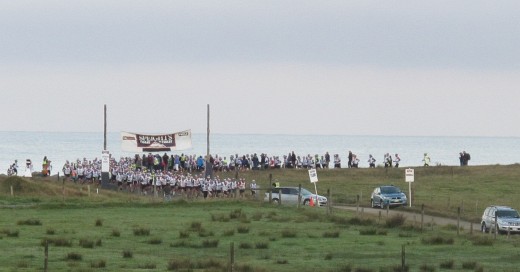

The top runners were going at a good clip. The leaders want to get together into a group to push the pace together on the 55 km bike.

By the middle of the pack, racers were going at a more moderate pace. The last few competitors alternated walking and running as they went up a small rise a few hundred meters from the start. I was glad to see racers pacing themselves carefully at the start of a 243-km event. (Cue the ominous, foreshadowing music...)

After stopping in town to shop for some final supplies (the first of several "final" trips to town), we headed back to our motel to work on some pre-race projects. First on the list was some boatbuilding to make Jack's kayak more hydrodynamic after its recent repair.

Jack obviously needed to practise getting into his kayak since his first instinct wasn't so good. ;)

Chris and Jack also practised the way to get him out of the kayak when he arrives at the Gorge Bridge. After 4-6 hours in a kayak, paddlers may have trouble getting out on their own. Their leg muscles are probably sore and their feet may be numb. As a special treat for their support crew carrying the boat uphill to the vehicle, the kayak is often sloshing with urine. (We did not practise that...)

I had a few last-minute things to set up on my kayak then Richard practised lifting me out too.

At high noon, we scheduled a walkthrough of the entire race on the dining room table using items from our kitchenette. Here was the van starting the race with two kayaks on the roof.

The car was a small basket. I was represented by the wine glass with pink carabiner. Jack was represented by a can of beans. (Heard of Jack and the Beanstalk?) Each transition was represented by a piece of paper. As we moved along the dining room table, i.e. through the race, we referred to the times on our Gantt chart and determined which of our two support crews (Team Car and Team Van) would take care of each task, when they could have lunch, when they might have wireless Internet access or cell coverage, etc. The support crew added to their copious notes. This took 90 minutes!

I filled bladders, put food in pack pockets, finalized the "transition tasks" list for my support crew and organized my gear so they could locate it easily.

We figured out a way that I could carry the SPOT on each leg so it could easily be transferred to different packs and my PFD. For the mountain run, I planned to carry eLoad and drink water from the rivers, so Richard devised a way to clip a small plastic cup onto my vest pack. It was tucked into the vest when I wasn't using it. I had a similar drinking cup carabinered to my kayak skirt without any loose cord.

We loaded the vehicles in the evening since our alarm was set for 4 a.m. Before turning off the light, I read through the guidebook one last time, reviewing the photos of the river crossing locations on the mountain run and the various rapids on the Waimakariri River ("in Boulder Garden #2, start on the left then paddle quickly to the right to avoid the big rock at the bottom"). Then lights out.
P.S. As I write this, I realize how geeky this may sound! Because I'm not fast, I need to focus on little details. Those are the things I can improve on and hopefully learn to do almost as well as the top racers. More importantly for us, when someone is racing at Jack's level, every second matters. He leaves nothing to chance. Every detail is pre-planned. Every race activity is well-rehearsed - not just the athletic training. Very inspiring and interesting for us all to watch.
About 75-80% of participants do the 2-day version of Coast to Coast. You can do it as an individual or as a relay team. On Day 1, they do the 3 km road run, the 55 km bike ride and the 33 km mountain run, then they camp at Klondyke Corner. Relay teams switch at the end of the bike ride. On Day 2, the kayaker (who cannot also do the mountain run) bikes 15 km to the river and does the 67 km paddle then the other teammate rides 70K to Christchurch.
Because they have a shorter day, they start at 7 a.m. We thought it would be good practice for us to get up early and drive to the race start in Kumara - plus it would be cool to see what the start looked like!

It was just getting light when the gun went off. The 1-day race will start tomorrow at 6 a.m. when it's still dark.


The top runners were going at a good clip. The leaders want to get together into a group to push the pace together on the 55 km bike.
By the middle of the pack, racers were going at a more moderate pace. The last few competitors alternated walking and running as they went up a small rise a few hundred meters from the start. I was glad to see racers pacing themselves carefully at the start of a 243-km event. (Cue the ominous, foreshadowing music...)
After stopping in town to shop for some final supplies (the first of several "final" trips to town), we headed back to our motel to work on some pre-race projects. First on the list was some boatbuilding to make Jack's kayak more hydrodynamic after its recent repair.
Jack obviously needed to practise getting into his kayak since his first instinct wasn't so good. ;)
Chris and Jack also practised the way to get him out of the kayak when he arrives at the Gorge Bridge. After 4-6 hours in a kayak, paddlers may have trouble getting out on their own. Their leg muscles are probably sore and their feet may be numb. As a special treat for their support crew carrying the boat uphill to the vehicle, the kayak is often sloshing with urine. (We did not practise that...)

I had a few last-minute things to set up on my kayak then Richard practised lifting me out too.

At high noon, we scheduled a walkthrough of the entire race on the dining room table using items from our kitchenette. Here was the van starting the race with two kayaks on the roof.
The car was a small basket. I was represented by the wine glass with pink carabiner. Jack was represented by a can of beans. (Heard of Jack and the Beanstalk?) Each transition was represented by a piece of paper. As we moved along the dining room table, i.e. through the race, we referred to the times on our Gantt chart and determined which of our two support crews (Team Car and Team Van) would take care of each task, when they could have lunch, when they might have wireless Internet access or cell coverage, etc. The support crew added to their copious notes. This took 90 minutes!
I filled bladders, put food in pack pockets, finalized the "transition tasks" list for my support crew and organized my gear so they could locate it easily.

We figured out a way that I could carry the SPOT on each leg so it could easily be transferred to different packs and my PFD. For the mountain run, I planned to carry eLoad and drink water from the rivers, so Richard devised a way to clip a small plastic cup onto my vest pack. It was tucked into the vest when I wasn't using it. I had a similar drinking cup carabinered to my kayak skirt without any loose cord.
We loaded the vehicles in the evening since our alarm was set for 4 a.m. Before turning off the light, I read through the guidebook one last time, reviewing the photos of the river crossing locations on the mountain run and the various rapids on the Waimakariri River ("in Boulder Garden #2, start on the left then paddle quickly to the right to avoid the big rock at the bottom"). Then lights out.
P.S. As I write this, I realize how geeky this may sound! Because I'm not fast, I need to focus on little details. Those are the things I can improve on and hopefully learn to do almost as well as the top racers. More importantly for us, when someone is racing at Jack's level, every second matters. He leaves nothing to chance. Every detail is pre-planned. Every race activity is well-rehearsed - not just the athletic training. Very inspiring and interesting for us all to watch.
Thursday Feb 10, 2011 #
Note
Signing off now. Race day is tomorrow. It's almost dinnertime Fri. night in NZ. If you're interested in keeping an eye on Jack and me as we race Coast to Coast, we start on Sat. at 6 a.m. in New Zealand. That's Friday noon in Toronto. Jack should be finished 12 hrs later. I'm aiming for 17 hrs, i.e. Sat. 5 a.m. at home.
Live race coverage is here - it's already started for the 2-day race. They'll mention the leaders here so be sure to cheer for Jack!
<http://www.sportzhubevents.com/ctc2011/#>
My SPOT tracker is here. This should be the most current info on what I'm doing. There won't be any messages until just before the race starts.
<http://share.findmespot.com/shared/faces/viewspots...>
Richard will attempt to update my Facebook status.
<http://www.facebook.com/Barb.J.Campbell>
Jack's team will be updating the Van Dorp Racing page. Anyone can "like" this page.
<http://www.facebook.com/vandorpracing>
Thanks so much for the long distance support. I don't know if I can do this thing but I'm going to try my hardest. Catch you on the other side!
Live race coverage is here - it's already started for the 2-day race. They'll mention the leaders here so be sure to cheer for Jack!
<http://www.sportzhubevents.com/ctc2011/#>
My SPOT tracker is here. This should be the most current info on what I'm doing. There won't be any messages until just before the race starts.
<http://share.findmespot.com/shared/faces/viewspots...>
Richard will attempt to update my Facebook status.
<http://www.facebook.com/Barb.J.Campbell>
Jack's team will be updating the Van Dorp Racing page. Anyone can "like" this page.
<http://www.facebook.com/vandorpracing>
Thanks so much for the long distance support. I don't know if I can do this thing but I'm going to try my hardest. Catch you on the other side!
9 PM
Note
Almost there! Jack developed a Gantt Chart last night for our two support crews and went over maps with 'Bent. Both crews will support Jack at different points to make things more efficient for him at the front of the race. I'll get by just fine with one crew!

We're mostly down to last-minute fussing with gear and food. I had to clean my boat and shoes to prevent the spread of didymo - an invasive species of algae. (We need to sign a form about this at registration.) Tomorrow we'll need to do more transition practice with support crew.
Today 'Bent and I figured out how to attach little plastic cups to my kayak skirt and Salomon vest pack so I can drink from rivers easily on the paddle and run. The one remaining task is to find a way to transfer the SPOT unit easily as I change disciplines. My iPhone has been wonky so the SPOT unit might be the only info available on my race. If the iPhone works, there'll be some updates on my Facebook profile. Jack's crew will be updating his Facebook page, "Van Dorp Racing" and there should also be updates on his progress on the main race website.
Because most racers do the two-day event, i.e. the same race course but at a more reasonable pace, the race registration, banquet and briefing were tonight. Registration was low key. Nice beer garden, a few vendor booths. I was one of the few racers picked for a mandatory gear check.


I've never seen so many expensive bikes and kayaks in one small town!

I've decided to bring my kayak home to Canada with me - assuming that it survives the race. The river is still high which is probably good since it will be similar to the way it was when we paddled it. Also, our paddle will go faster. But if I go for a swim, it could be a really, really long one. Speaking of kayaks, here's the hot pink one Elina Ussher paddles. It doesn't look as narrow and tippy as I would have expected from someone who has won the race.

The Kumara ladies put on a yummy banquet for over 1,000 people in two sittings. Apparently, it is the only fundraiser the local school needs each year. Our NZ support crew member, Andrew Connochie arrived to join us tonight.

'Bent made a new friend in Kumara.

I had the pleasure of meeting well-known adventure racer Steve Gurney and race director Robin Judkins. They are racing together in the 2-day event this year.

We're mostly down to last-minute fussing with gear and food. I had to clean my boat and shoes to prevent the spread of didymo - an invasive species of algae. (We need to sign a form about this at registration.) Tomorrow we'll need to do more transition practice with support crew.
Today 'Bent and I figured out how to attach little plastic cups to my kayak skirt and Salomon vest pack so I can drink from rivers easily on the paddle and run. The one remaining task is to find a way to transfer the SPOT unit easily as I change disciplines. My iPhone has been wonky so the SPOT unit might be the only info available on my race. If the iPhone works, there'll be some updates on my Facebook profile. Jack's crew will be updating his Facebook page, "Van Dorp Racing" and there should also be updates on his progress on the main race website.
Because most racers do the two-day event, i.e. the same race course but at a more reasonable pace, the race registration, banquet and briefing were tonight. Registration was low key. Nice beer garden, a few vendor booths. I was one of the few racers picked for a mandatory gear check.

I've never seen so many expensive bikes and kayaks in one small town!

I've decided to bring my kayak home to Canada with me - assuming that it survives the race. The river is still high which is probably good since it will be similar to the way it was when we paddled it. Also, our paddle will go faster. But if I go for a swim, it could be a really, really long one. Speaking of kayaks, here's the hot pink one Elina Ussher paddles. It doesn't look as narrow and tippy as I would have expected from someone who has won the race.
The Kumara ladies put on a yummy banquet for over 1,000 people in two sittings. Apparently, it is the only fundraiser the local school needs each year. Our NZ support crew member, Andrew Connochie arrived to join us tonight.

'Bent made a new friend in Kumara.

I had the pleasure of meeting well-known adventure racer Steve Gurney and race director Robin Judkins. They are racing together in the 2-day event this year.

Wednesday Feb 9, 2011 #
Road Biking 29:00 [3] 13.3 km (27.5 kph)
Transition practice. Run/bike/run/bike. Frankenjack was so much faster than me at switching from running to bike shoes that my head was spinning.


He had 150 meters on me before I was on my bike. We had a little shoe-change coaching session afterward and my speed has improved. The secret was to modify my shoes somewhat. I don't need no stinkin' laces!


We rode from our hotel and turned onto a road that had some big bends and a pretty good hill. I got up to 51 kph going downhill. When I turned around to come back, it wasn't quite as impressive, particularly in the wind. Trucks whizzed by a few inches away. Not my thing. But I'm still going to let Revy try to convince me. :)

He had 150 meters on me before I was on my bike. We had a little shoe-change coaching session afterward and my speed has improved. The secret was to modify my shoes somewhat. I don't need no stinkin' laces!


We rode from our hotel and turned onto a road that had some big bends and a pretty good hill. I got up to 51 kph going downhill. When I turned around to come back, it wasn't quite as impressive, particularly in the wind. Trucks whizzed by a few inches away. Not my thing. But I'm still going to let Revy try to convince me. :)
Running (Road) 22:00 [4]
shoes: Salomon XA Pro Ult - 2 Tomato
Off the bike and onto the run. 'Bent was practising handing me things and taking things away. I can no longer hide the truth... as you can see here, I'm going to wear a Camelbak on a road bike so I can focus on drafting in a bunch. I realize that if I had any road biking cred, I would totally lose it over this decision. But that's OK - I don't.

More shoe-change practice is needed.

I was just planning a token run but I felt strangely obligated to meet the Urthbuoy standard of "20 minutes or it's not a brick". Stoopid Urthbuoy and his resolutions. 'Bent came with me and Chris joined us for the last section after he'd run with Frankenjack, so it was nice and social.
More shoe-change practice is needed.
I was just planning a token run but I felt strangely obligated to meet the Urthbuoy standard of "20 minutes or it's not a brick". Stoopid Urthbuoy and his resolutions. 'Bent came with me and Chris joined us for the last section after he'd run with Frankenjack, so it was nice and social.
10 AM
Note
We drove south to Hokitika for some pre-race chillaxing. As Bender pointed out, there is a Sock Museum in town.
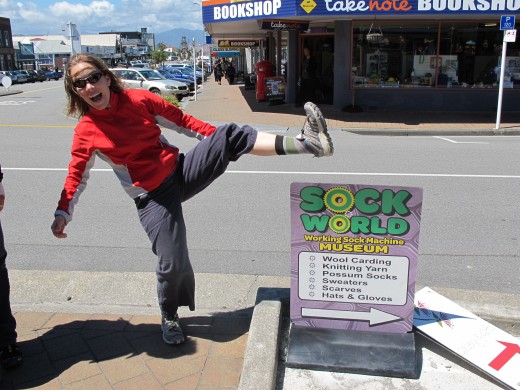
We elected to skip it and spent most of our time in shops or on the beach. It was cool and the surf was high (maybe cyclone related?) so no one was tempted to swim.

Note that I am continuing to wear my "safe journey over water" pendant.

There had been a recent driftwood sculpture contest on the beach. Some of the entries were worse for the wear but others looked great. It was like walking around ice sculptures after a short thaw.

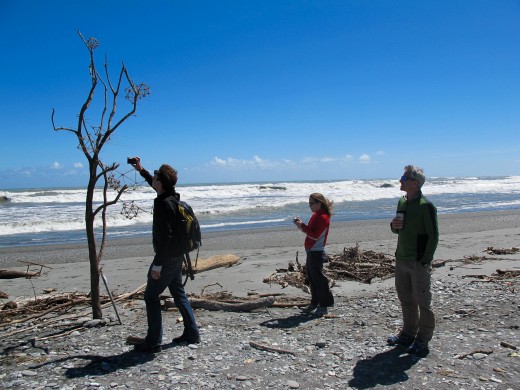
This was the overall winner.

This guy was very cool.

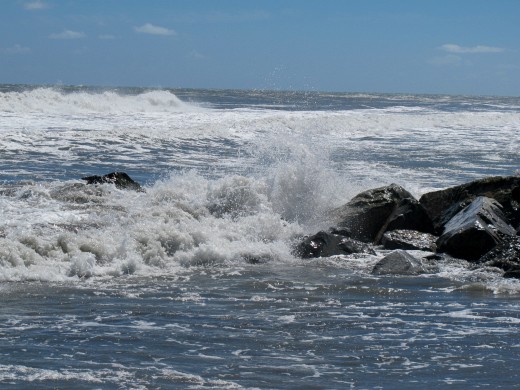
We drove out of town to hike into Hokitika Gorge, a place that gets 7.5 m of rain a year - over twice as much as the town.

It felt like we'd been teleported to Costa Rica.




Nice gorge and suspension bridge.

Of course I had to check out the way eddies and boils were forming around the bluffs. There are a lot of bluffs on the Waimakariri River so it's been on my mind.
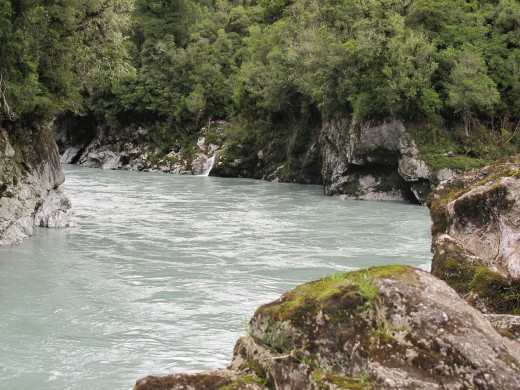
On the way back, we visited the Coast to Coast starting line at Kumara. The race is in its 29th year and there is a permanent marker with a plaque. We'll be going from here into those mountains behind us, starting with a 3 km road run to a 55 km bike leg.

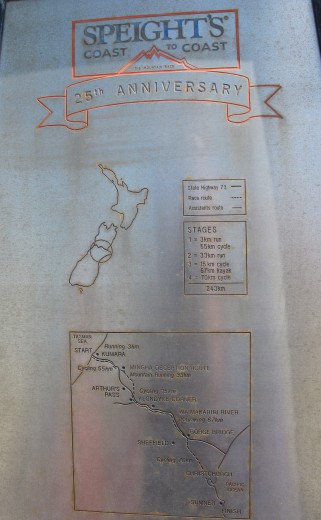
Frankenjack and I looked at the Tasman Sea where we'll be dipping our toes on Saturday morning in the dark.

I walked down onto the beach where we'll be starting. The first thing we'll do is run up those rocks to get onto the road. I practised doing that a couple of times.

'Bent and our other support crew members won't come to Kumara on race day so he went down to the water's edge as well.

We elected to skip it and spent most of our time in shops or on the beach. It was cool and the surf was high (maybe cyclone related?) so no one was tempted to swim.

Note that I am continuing to wear my "safe journey over water" pendant.

There had been a recent driftwood sculpture contest on the beach. Some of the entries were worse for the wear but others looked great. It was like walking around ice sculptures after a short thaw.


This was the overall winner.

This guy was very cool.


We drove out of town to hike into Hokitika Gorge, a place that gets 7.5 m of rain a year - over twice as much as the town.
It felt like we'd been teleported to Costa Rica.

Nice gorge and suspension bridge.
Of course I had to check out the way eddies and boils were forming around the bluffs. There are a lot of bluffs on the Waimakariri River so it's been on my mind.
On the way back, we visited the Coast to Coast starting line at Kumara. The race is in its 29th year and there is a permanent marker with a plaque. We'll be going from here into those mountains behind us, starting with a 3 km road run to a 55 km bike leg.

Frankenjack and I looked at the Tasman Sea where we'll be dipping our toes on Saturday morning in the dark.
I walked down onto the beach where we'll be starting. The first thing we'll do is run up those rocks to get onto the road. I practised doing that a couple of times.
'Bent and our other support crew members won't come to Kumara on race day so he went down to the water's edge as well.
Tuesday Feb 8, 2011 #
Note
Our 8 nights in Christchurch flew by. Today we drove to the west coast to stay near Kumara where we'll start Coast to Coast. 'Bent and Frankenjack did a masterful packing job, filling the van with 2 bicycles, gear for 5 people (including bulky camping and race gear), groceries and more. We all got a seat although some of us had backpacks under our legs. You may wonder why there's only one kayak on the roof. Frankenjack's is in the shop. Without naming names, let's just say that one of us avoided rocks on the Waimak better than the other. :)
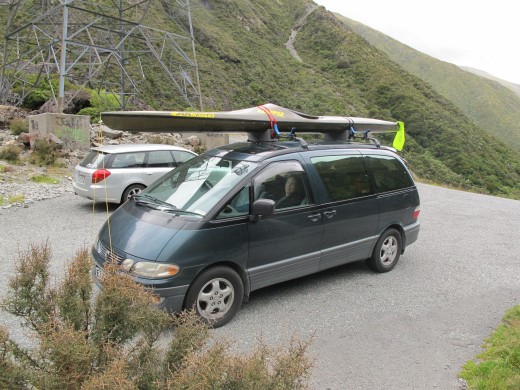
The road to Arthur's Pass National Park has become very, very familiar over the past week. This is the west side of the pass. If the rivers are too high, we will be running this steep road as part of the "Plan B" race course, which mostly consists of road biking and road running.

For the first time, we continued past the Deception Valley and drove in the reverse direction on the 55 km bike leg that we'll do near the start of the race. (We begin with a 3 km run from a beach on the Tasman Sea to the bikes.) From reading about the race, it sounds like the big challenge in this section will be riding in a peleton or "bunch" as they call it here. The first part of the challenge is running fast enough to your bike and changing your shoes (if you do) so you can get into a bunch. If you succeed, there are the usual challenges of riding in a group of people you don't know - avoiding each other's tires and praying that the people ahead of you don't crash.
Frankenjack advises staying on the left so I can ride onto the grass if anything happens ahead of me. (Remember that we'll be riding on the left side of the road.) It's safer to be near the front of the bunch although you don't want to end up working too hard and taking other people along for a free ride. We'll be climbing over 300 meters and there are a couple of steep sections, so it's going to be a great way to warm up for a long day!
It rains more on the west coast and the vegetation became more lush as we drove.

We're staying in the country north of Greymouth. Not much going on here - should be a great, restful place for our final preparations.

Because Bender was kind enough to recommend a good restaurant for our dinner, we went for Indian food tonight. It turns out Priya has several locations in the area so we went to the one in Greymouth. Yummy food - thanks for the suggestion!

The road to Arthur's Pass National Park has become very, very familiar over the past week. This is the west side of the pass. If the rivers are too high, we will be running this steep road as part of the "Plan B" race course, which mostly consists of road biking and road running.
For the first time, we continued past the Deception Valley and drove in the reverse direction on the 55 km bike leg that we'll do near the start of the race. (We begin with a 3 km run from a beach on the Tasman Sea to the bikes.) From reading about the race, it sounds like the big challenge in this section will be riding in a peleton or "bunch" as they call it here. The first part of the challenge is running fast enough to your bike and changing your shoes (if you do) so you can get into a bunch. If you succeed, there are the usual challenges of riding in a group of people you don't know - avoiding each other's tires and praying that the people ahead of you don't crash.
Frankenjack advises staying on the left so I can ride onto the grass if anything happens ahead of me. (Remember that we'll be riding on the left side of the road.) It's safer to be near the front of the bunch although you don't want to end up working too hard and taking other people along for a free ride. We'll be climbing over 300 meters and there are a couple of steep sections, so it's going to be a great way to warm up for a long day!
It rains more on the west coast and the vegetation became more lush as we drove.
We're staying in the country north of Greymouth. Not much going on here - should be a great, restful place for our final preparations.
Because Bender was kind enough to recommend a good restaurant for our dinner, we went for Indian food tonight. It turns out Priya has several locations in the area so we went to the one in Greymouth. Yummy food - thanks for the suggestion!

Monday Feb 7, 2011 #
Note
It was 36C in Christchurch yesterday. We don't have A/C so we were melting while reading everyone's AP logs about playing in the snow back home. Gotta admit, we were jealous.
Today is 14C with rain pelting down. There are two cyclones near NZ but the weather is currently forecast to be relatively clear around the race course for a couple of days before C2C. This matters because the course will have to be altered dramatically if the rivers are high. That's what happened to Frankenjack last year and that's why he came back. Neither the mountain run nor the Waimakariri paddle can happen if the river is too high. It has been too high on several days since we arrived, including today/tomorrow.
We're leaving Christchurch to head to the west coast tomorrow. We have 4 nights there before C2C although we'll be setting the alarm before 4 a.m. on the last night so maybe it shouldn't count.
Frankenjack has seen the light and purchased a fast-looking pair of black Salomon Speedcross shoes for the mountain run. I'll be in Salomon XA Pros. I normally wear SLAB Wings for trail races but the Deception Valley terrain is too rough for me to go that light.
Most of my pre-race shopping is done. The bed is covered with little piles of clothing and gear for each transition. Gels and bars are in a central heap waiting to be divvied up.
We're still fussing with some final details like our kayak drinking systems. The current best idea is a long piece of tubing that we'll use like a straw to sip from the river, which is potable. Alternate plan is a plastic cup for dipping. I'll also have eLoad on the back of my PFD - but less is better since the bladder is above my centre of gravity.
To keep the river gods happy, I started wearing my "safe journey over water" pendant today.
Today is 14C with rain pelting down. There are two cyclones near NZ but the weather is currently forecast to be relatively clear around the race course for a couple of days before C2C. This matters because the course will have to be altered dramatically if the rivers are high. That's what happened to Frankenjack last year and that's why he came back. Neither the mountain run nor the Waimakariri paddle can happen if the river is too high. It has been too high on several days since we arrived, including today/tomorrow.
We're leaving Christchurch to head to the west coast tomorrow. We have 4 nights there before C2C although we'll be setting the alarm before 4 a.m. on the last night so maybe it shouldn't count.
Frankenjack has seen the light and purchased a fast-looking pair of black Salomon Speedcross shoes for the mountain run. I'll be in Salomon XA Pros. I normally wear SLAB Wings for trail races but the Deception Valley terrain is too rough for me to go that light.
Most of my pre-race shopping is done. The bed is covered with little piles of clothing and gear for each transition. Gels and bars are in a central heap waiting to be divvied up.
We're still fussing with some final details like our kayak drinking systems. The current best idea is a long piece of tubing that we'll use like a straw to sip from the river, which is potable. Alternate plan is a plastic cup for dipping. I'll also have eLoad on the back of my PFD - but less is better since the bladder is above my centre of gravity.
To keep the river gods happy, I started wearing my "safe journey over water" pendant today.